Dipsacaceae (Teasel family)
At a Glance
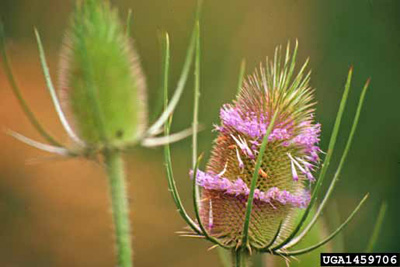
© Steve Dewey / Utah State University
- Biennial
- Spends at least the first year after germination as a basal rosette, then grows a two- to eight-foot flowering stem.
- Stems are prickly and branch near the top.
- Basal rosette leaves are puckered with scalloped edges. Stem leaves appear similar, but they are smaller and opposite, and their bases fuse to form a cup around the stem.
- Flowers are very small and pack into dense, coneshaped heads. They are lavender in color.
- After flowering, the plant becomes woody and persists through the following winter.
Habitat and Ecology
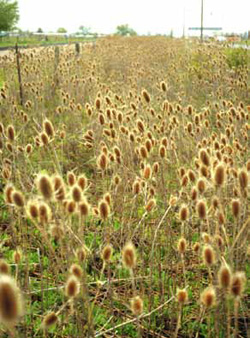
© Steve Dewey / Utah State University
Common teasel (Dipsacus fullonum) is currently found in most of the states in the United States. Native to Europe and temperate Asia, common teasel may have been introduced to North America as early as the 1700s. It was likely cultivated for its role in producing wool or as an ornamental. Its frequent use in dried flower arrangements may aid its dispersal; for example common teasel often occurs in and near cemeteries. Common teasel also commonly disperses along roads and waterways. It occupies sunny and open sites, such as riparian areas, meadows, grasslands, savannas, forest openings, and disturbed sites. Common teasel may not seriously reduce biodiversity, but it has the potential to become more of a problem invasive species.
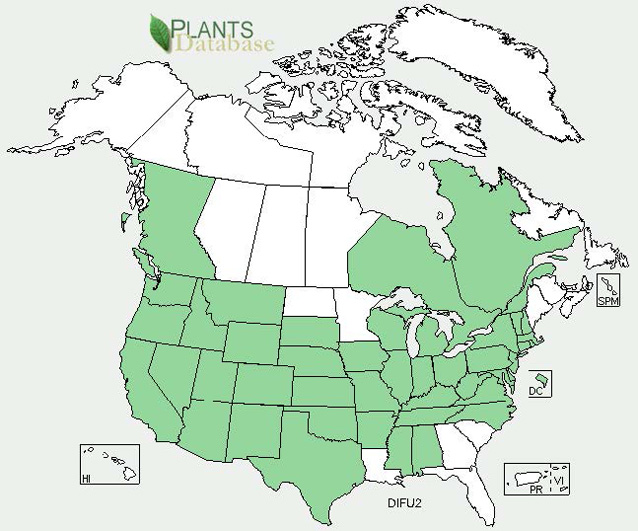
USDA
Description
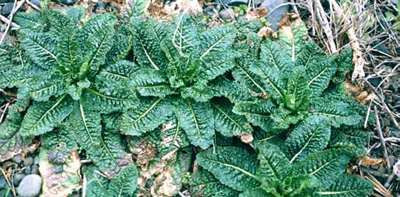
© Steve Dewey / Utah State University
Common teasel is a biennial forb that remains a basal rosette during its first year of growth and later grows a two to eight-foot tall flower stem. The number of years the plant takes to bolt strongly depends how large the rosette grows. The stems are prickly and branch near the top. After flowering, the stems become woody and persist through the following winter. The root system consists of a thick taproot and fibrous secondary roots. Common teasel reproduces by seeds that tend to fall within five feet of the parent plant. The seeds do not persist in the soil.
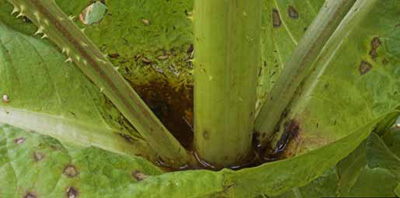
© Barry Rice
Leaves
The leaves of the basal rosette are puckered with scalloped edges. The stem leaves appear similar, but they are smaller and opposite, and they have short spines on the underside of the midrib. Basal rosette leaves have short stems, but stem leaves fuse around the flowering stem to form a cup that collects rainwater.
Flowers and Fruits
Each flower head contains 250 to 1,500 flowers that are packed into dense, cone-shaped heads. Each flower blooms for only one day. The flower itself has white petals united into a tube with four purple lobes. Four stiff, upwardly curving bracts are located underneath the flower head. Common teasel flowers April through August in California, and July through September in the Midwest and Northeast. The fruit is a hairy achene, or a dry fruit with a single seed and thin walls that does not open at maturity, like a sunflower “seed”.
Etymology
Dip’sacus comes from the Greek word dipsa, which means “thirst”. It refers to the fused leaf bases that collect rainwater. Fullon’um refers to fullers or people who full cloth, which is a process of shrinking or thickening cloth by moistening, heating and pressing.
Ethnobotany
The flowers of common teasel were used to tease wool.
Similar Species
Cutleaf teasel (Dipsacus laciniatus) has deeply lobed leaves and white flowers, but is otherwise very similar to common teasel.
Control Methods
Possible control methods are explained at these websites:
References
Cardina, J., C. Herms, T. Kock, and T. Webster. No date. Common teasel in Ohio Perennial and Biennial Weed Guide. Ohio Agricultural Research and Development Center Extension. Available at http://www.oardc.ohio-state.edu/weedguide/singlerecord.asp?id=850 (accessed 26 March 2010).
Charters, M. L. 2009. California plant names: Latin and Greek meanings and derivations. Available at http://www.calflora.net/botanicalnames (accessed 26 March 2010).
Gucker, C. L. 2009. Dipsacus fullonum, D. lacinatus. In Fire Effects Information System. US Department of Agriculture, Forest Service, Rocky Mountain Research Station, Fire Sciences Laboratory. Available at http://www.feis-crs.org/feis/ (accessed 26 March 2010).
Prepared by Kelly Reeves, Southern Colorado Plateau Network Inventory and Monitoring Program, 2010.
Last updated: May 3, 2016
